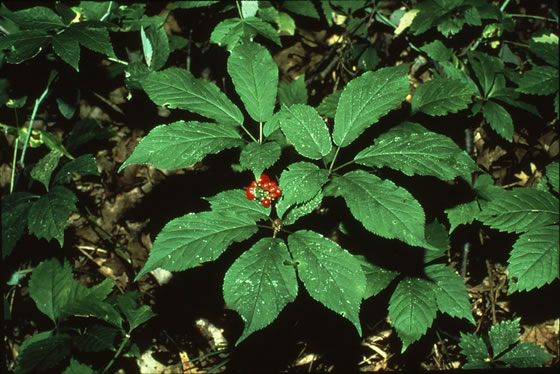
American ginseng plant. Image: U.S. Department of Agriculture Forest Service
By Carin Tunney and Chao Yan
While uprooting a plant may seem harmless, conservationists say the environmental consequences of removing ginseng could someday be severe.
The plant is highly vulnerable due to its market demand, especially in Asia where it is made into supplements.
The native plant is already considered endangered in Michigan. That’s why they rely on conservation officers and high-tech methods to prevent poachers who break harvesting laws in other Great Lakes states.

American ginseng is native to eastern North America. Image: U.S. Forest Service.
Conservation officers rely on tips and ask the public to report cars parked near forests, people carrying shovels or backpacks, or those with dirt-covered clothes. In southern Ohio, the DNR also educates police about ginseng theft and recommends looking for evidence of wild ginseng during drug arrests.
But poachers are difficult to catch, said New York Conservation Officer Nathan Doig who recently arrested someone in that state’s Delaware County and who said he was fishing but had $450 of illegal ginseng root and no fishing pole. Poachers often dress in camo and are dropped off in the woods.
But getting caught isn’t limited to being spotted in the woods, says Jim Corbin of the U.S. Department of Agriculture’s plant industry division.

The USDA uses a nutrient dye on plants that can trace the root back to federal lands. Image: North Carolina Department of Agriculture.
The Agriculture Department uses a high-tech method to track poachers on federal lands. Ginseng roots on public lands are fed a nutrient dye that leaves a forensic trace, Corbin says. Legal dealers face inspections and must list where each root is removed. Those records can be cross-checked through the dye in the roots to trace poached ginseng back to the thief.
“We go back and are able to utilize that in courtroom situations when they are stolen or when there is a violation where they go on national parks and national forests. We will make those seizures and read those individual codes that we mark the plants with,” Corbin says.

Nutrient dye is sprinkled adjacent to a ginseng root by USDA scientists. Image: North Carolina Department of Agriculture
The Agriculture Department also tracks the illegal sale of ginseng online through websites like Craig’s List and eBay. They target dealers and overseas trafficking.
For CITES-listed species to be exported, U.S. Fish and Wildlife Service authorities must determine that the wild American ginseng was legally harvested and won’t jeopardize survival of the species. Each year, the 19 states that regulate the harvesting of ginseng, report the previous year’s total harvest by county. The agency then uses that data, scientific research and other biological and trade information, to determine if the export will be detrimental.
Poaching can be a family tradition or common among foragers who go beyond the legal gathering of berries, nuts, mushrooms leeks and edible ferns, conservationists say.
Poachers also seek orchids, trillium and trees for their aesthetic value, they say.

Yellowroot or goldenrod is often poached for its medicinal claims. Image: Wisconsin Department of Natural Resources
More attention should be given to plant poaching and theft, says Matt Candeias, a community ecologist from Illinois and creator of the In Defense of Plants website and podcast, which have more than 21,000 followers.
“People get up in arms when they hear tigers are being poached or rhinos are being poached,” he says. “They don’t think about a plant as poaching. It is almost like plants don’t move and they don’t have the charisma of an eagle or a bear so they are not important.”
“When you think about protecting any kind of endangered species, plants are the habitat,” he says.
Some responsibility for plant poaching falls on consumers for not asking questions about the origin of the plants and plant-based products they buy as supplements or at nurseries, says Candeias.
“It’s market-driven. If people can understand that what they are buying increases the pressures on these organisms, maybe a difference could be made in that regard.”
Editor’s note: In Pursuit of Plants is a series of stories about the wild plant trade in the Great Lakes region.